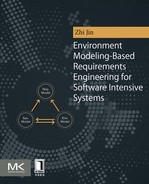Introduction
Some nonfunctional concerns are mainly derived from the properties of the environmental entities, e.g., dependability, adaptivity, security, safety. The environment modeling-based approach is helpful for an analysis of these nonfunctionalities because environment models characterize these properties. This part discusses some environment-related nonfunctionalities and presents approaches to eliciting, modeling, and specifying those nonfunctionalities.
This part includes three chapters, i.e., Chapters 11–13. Chapter 11 discusses system dependability. We assume that the dependability issue is derived from the characteristics of the system's interactive environment, including external entities or other systems that will interact with the system. Dependability is an issue because failing to deal appropriately with these external entities may cause negative effects or even disasters. This makes the system undependable.
Next, Chapter 11 introduces an approach to using the environment model as the background to identifying dependability concerns and integrating countermeasures to the threat. Chapter 11 also proposes modeling the dependability requirements as threat controllers. This leads to fine-grained function points to guarantee the system's dependability.
Adaptivity is another important feature in modern software systems, e.g., cyber-physical systems, mobile applications. Like dependability, adaptivity depends on the interactive environment of the system. The system needs to adapt its own behavior, mainly because of the changing environment. Chapter 12 clarifies the relationships among the three most important elements in requirements engineering: the requirements goal model, the interactive environment model, and the system configuration model. It proposes modeling the adaptation logic separately from the application logic. A view-based rule language is advised and defined to specify the adaptation logic. This simplifies the construction of the system model and facilitates the evolution of the model at runtime.
Nonfunctional concerns are not easy to elicit and analyze. Inspired by the Problem Frame approach (Jackson, 2001), Chapter 13 defines a set of nonfunctional requirement patterns in a problem-oriented way. These patterns can be used to capture the nonfunctional aspects and introduce appropriate nonfunctional requirements into the system's functional model. Afterward, extended capabilities corresponding to the original function capabilities will be obtained. During the capability extension, some new environment entities may be further identified or designed. These concerns about patterns can help to derive specifications for the extended capabilities.
..................Content has been hidden....................
You can't read the all page of ebook, please click here login for view all page.
